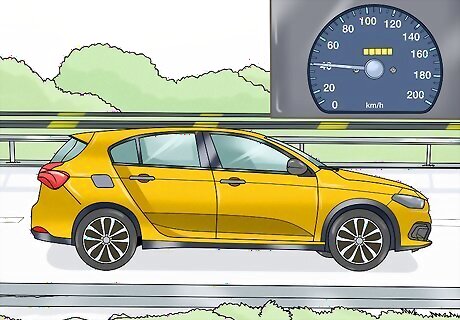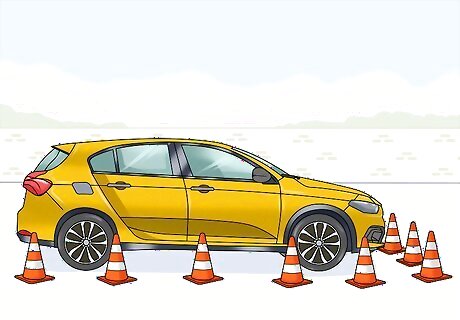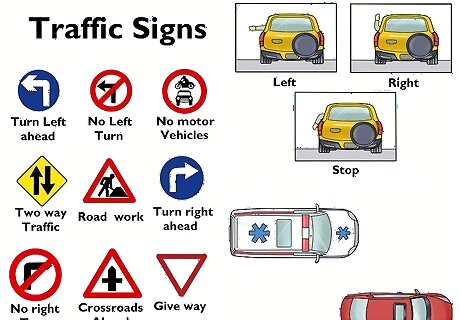
views
Passing the Practical Test

Make sure your car is ready for the test. Your registration and insurance should be easily accessible. Tires should be inflated properly and in good condition, lights will all need to be working, windshield wipers functional, with the washer reservoir filled, all instruments—especially the speedometer—working and accurate, and turn the radio off when you get there. There should be no cracks in the windshield. Make sure your car isn't belching smoke. If the examiner feels like your car might be unsafe, they can turn you away. Adjust the seat to fit your body height and style. You should sit at least 10 inches (25cm) from the steering wheel and your hands should be bent at approximately 45 degrees, holding the steering wheel at 9 o'clock and 3 o'clock. Make sure your feet reach the pedals properly, so you're not stretching to reach them, or bunched up in your seat.

Arrive at least 15 minutes prior to your appointment. Bring your completed and signed Driver's Log, Drivers Ed certificate, driving time with an instructor certificate, your learners permit, and any other papers or certificates required, including your Social Security card and birth certificate for identification purposes.

Greet the examiner politely. Relax and be friendly. You won't lose points for being unpleasant—necessarily—but if your examiner needs to make a judgment call about your driving at some point, ask yourself: would you be easier on a nice person or a rude one? Ask any questions that you have prior to the test and in the test if you are confused. The driving examiner will be glad to answer them.

At all times drive at a safe speed. Note that this does not necessarily mean the speed limit—conditions may warrant a slower speed. Under no circumstances exceed the speed limit.

Practice situational awareness. Check your mirrors regularly. Make this a little more exaggerated than normal, just so it is clear that you are doing it. Keep your head moving, looking out the windows for other traffic, pedestrians, kids, little old ladies, etc. Keep your eyes on the road, not on that good-looking guy or hot girl walking down the sidewalk. Your examiner will see them too, and check to see what has your attention: the road, or the hotness. If you want to pass, the answer needs to be "the road." When you change lanes or turn, turn your head to look behind you. Your rear-view mirrors are useful, but they're not foolproof. A combination of eyes and mirrors are the best.

Obey all signs. Come to a full stop at stop signs. Look all ways before continuing. If there are other people at the stop sign, make sure you yield right of way properly—and take your turn when it's time. Don't forget to signal all turns, lane changes, and any time your intent is to change direction.

Park confidently. Practice with your driving instructor or parent before taking the test so that you can do a clean, confident job of parallel parking, backing up straight, and three- or four-point turns. Parallel park as best as you can. Make sure you turn on your indicators, as not doing so will likely ensure a failure. Try not to bump the curb; go slowly and carefully, looking to the back and sides as you do so. Remember, it's OK to slightly bump the curb, just not jump it. You will lose some points, but that's better than failing the test altogether.

Thank the examiner. When you return to the motor vehicle department, listen to what the examiner has to say. Most likely they will mention what you did wrong, and a little of what you did right. Then they'll tell you if you passed or failed. Whichever it is, thank them politely. If you passed, you'll be pleased, and it's always nice to be polite. If you failed, you'll have to come back—and you might get the same examiner the next time. If you fly off the handle and call the examiner a "nail biting old crank who needs new glasses," it will probably go a lot harder on you next time!

Congratulations, you passed! If you read this tutorial, and studied the manual, you will almost certainly pass your driver's exam. Be safe out there!
Preparing for the Practical Test

Practice driving. Most states have regulations regarding how much experience you have behind the wheel. Some states make allowances for taking accredited driving courses, either through school or professional instruction. Some states also make allowances for top students. While it won't directly help you pass your driving test, being a good student will often make it easier to meet the requirements. Student drivers must have a licensed driver with them at all times. In some states, having a license is all your passenger needs. In some states there are age restrictions, or restrictions based on how long the person has been licensed. You will learn these rules and restrictions in the driver's manual that you're going to study.

Practice driving on the test routes. Find out in advance where you will be taking the practical test (the actual driving part). While it may be illegal in your state (read the manual), unless you're following specific routes, there should be no problem driving in the general neighborhood. That's not generally necessary, unless you are such an inexperienced driver that you need an advantage. If that's the case, you're better off not rushing into getting a license. Practicing all the basic maneuvers—stopping, starting, signaling, backing up, parking, obeying the speed limit and all traffic control signs and signals are all good things to practice. One of the biggest things the examiner will look for is whether or not you have full command of your vehicle. If you are intimidated by the car, make jerky starts and stops, and generally show a lack of confidence in your driving, that will count against you. If you speed, run a light or a stop sign, or make other egregious errors, you can pretty much count on retaking the test.

Be familiar with signage. Knowing street signs, hand gestures, when to pass, how and when to pull over for emergency vehicles will count. Read that manual! Know the rules and you'll be fine.

Go for a drive with your parent. The morning before your test, ask them to watch you, and make sure that you check all your mirrors correctly and do all your maneuvers correctly. This will help you gain some confidence.
















Comments
0 comment